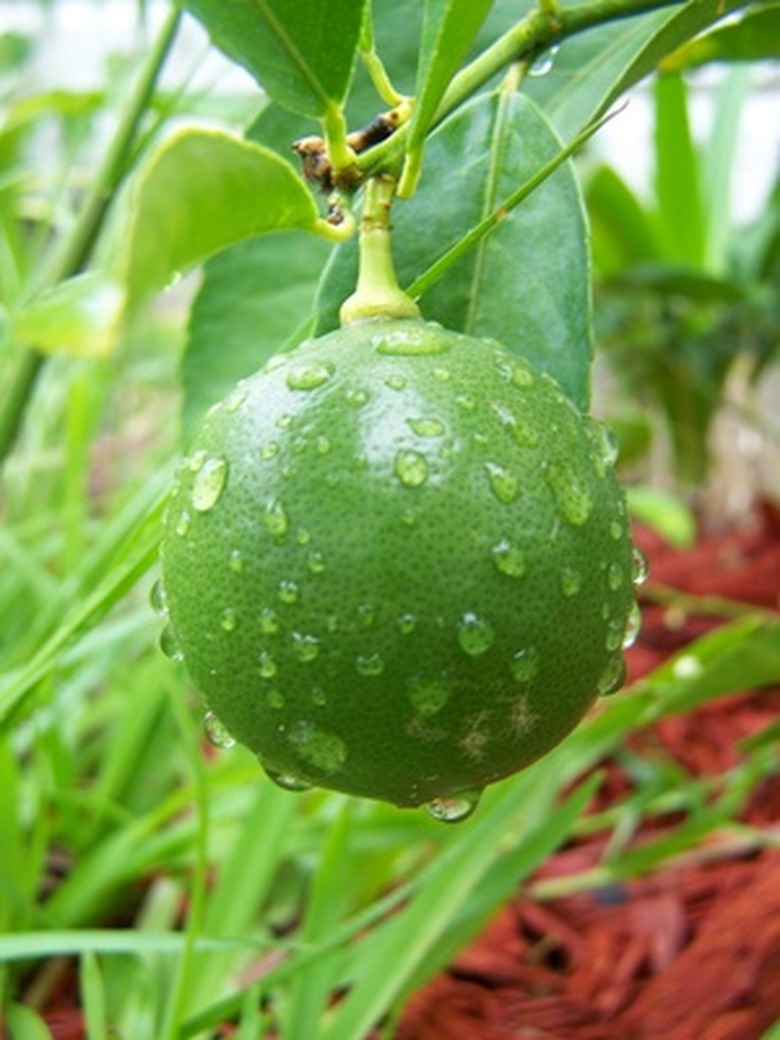How Do Limes Reproduce?
Like all citrus trees, limes can reproduce sexually. This means that male pollen from citrus flowers (either from the same tree or from a different tree) fertilizes a flower's female ovary to produce a seed that can grow into a mature plant. Key limes grow "true" to the characteristics of parent trees when grown from seed, but this is not generally true of other types of limes – or other kinds of citrus trees. With these types of limes the process of grafting is used to create new lime trees with fruits that have expected and desired characteristics.
What is Grafting?
What is Grafting?
Most types of limes are propagated commercially through grafting, which produces clones, or genetically identical plants. Through the process of grafting, a rootstock (lower portion of one plant) is joined to a scion (a shoot or bud from another plant) in such a way that the plant tissues from the two parent plants eventually fuse and grow as one plant.
Grafting is the preferred propagation practice for citrus trees, notes Texas A&M University Extension, because in a given growing region only a few citrus varieties have roots that successfully resist typical diseases and pests. Yet other trees produce more and better fruit. Because any variety or species of citrus can be successfully grafted onto any other type of citrus – limes and lemons onto orange trees, for example – citrus trees are usually created this way, which allows the most desirable fruit to be grown on the strongest rootstock.
Lime Seed Propagation
Lime Seed Propagation
Lime seeds can easily be grown as trees, but with the exception of key limes it's hard to know what you'll get. Also, University of Florida IFAS Extension notes that it takes many years for a citrus tree grown from seed to produce fruit, so this is not a recommended method of propagating lime trees.
To grow limes from seed, pluck seeds from fruit, wash them, rinse with a diluted solution of bleach and then plant seeds 1/4 inch deep in a sterile planting medium. Speed a seedling tree's maturity by using it as budwood – to graft it as buds onto other rootstock – when it's as big around as a pencil.
Layering and Cuttings
Layering and Cuttings
It's also possible to propagate a new lime or other citrus tree through layering on larger branches, though this approach is useful only if you'll be satisfied with a tree growing on its own root system. You can also take cuttings of green wood from smaller branches and root them as new trees, with the same limitation.
Budding Lime Trees
Budding Lime Trees
The process of budding, a specialized form of grafting, involves skillfully grafting young, green, budded wood onto desired rootstock. Budding allows desired types of limes or other citrus fruit to be grafted onto the most advantageous rootstock for a given growing region, greatly enhancing plant success. Collect budwood from a lime tree's second-to-last growth flush.
Grafting Cocktail Trees
Grafting Cocktail Trees
The grafting adaptability of citrus trees makes it possible to customize one or more citrus trees by "top-working" them, an intriguing home gardening project. Create a multi-variety lime tree – one with all the fruit needed for cocktails – by budding branches of different limes onto a lemon, orange or grapefruit tree. Or combine limes with lemons and oranges on one tree. Thriving rootstock is the key to grafting cocktail trees.
Seed Experimentation
Seed Experimentation
Commercial growers want predictability in the fruit they produce – for example, Satsuma mandarins should taste just like all other Satsumas, because fruit lovers expect consistency. Therefore, taking a "let's see what we get" approach has little value. Curiosity rather than crop demands can be a guiding principle for home gardeners with adequate space. Growing different types of limes from seed is a worthy challenge, though it may take ten years for trees to bear fruit and the experiment to end.
Cite This Article
MLA
Joyce, Kim. "How Do Limes Reproduce?" sciencing.com, https://www.sciencing.com/how-do-limes-reproduce-12323348/. 30 September 2021.
APA
Joyce, Kim. (2021, September 30). How Do Limes Reproduce?. sciencing.com. Retrieved from https://www.sciencing.com/how-do-limes-reproduce-12323348/
Chicago
Joyce, Kim. How Do Limes Reproduce? last modified March 24, 2022. https://www.sciencing.com/how-do-limes-reproduce-12323348/
